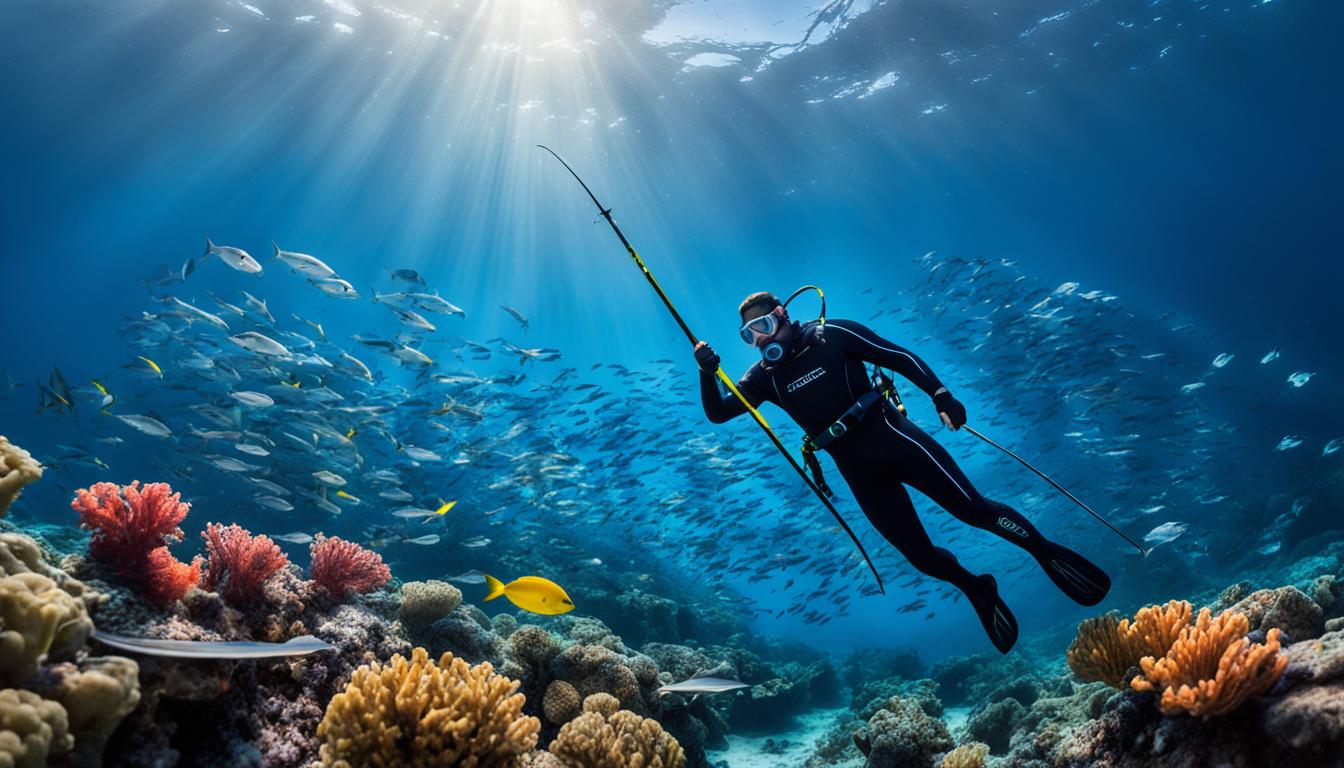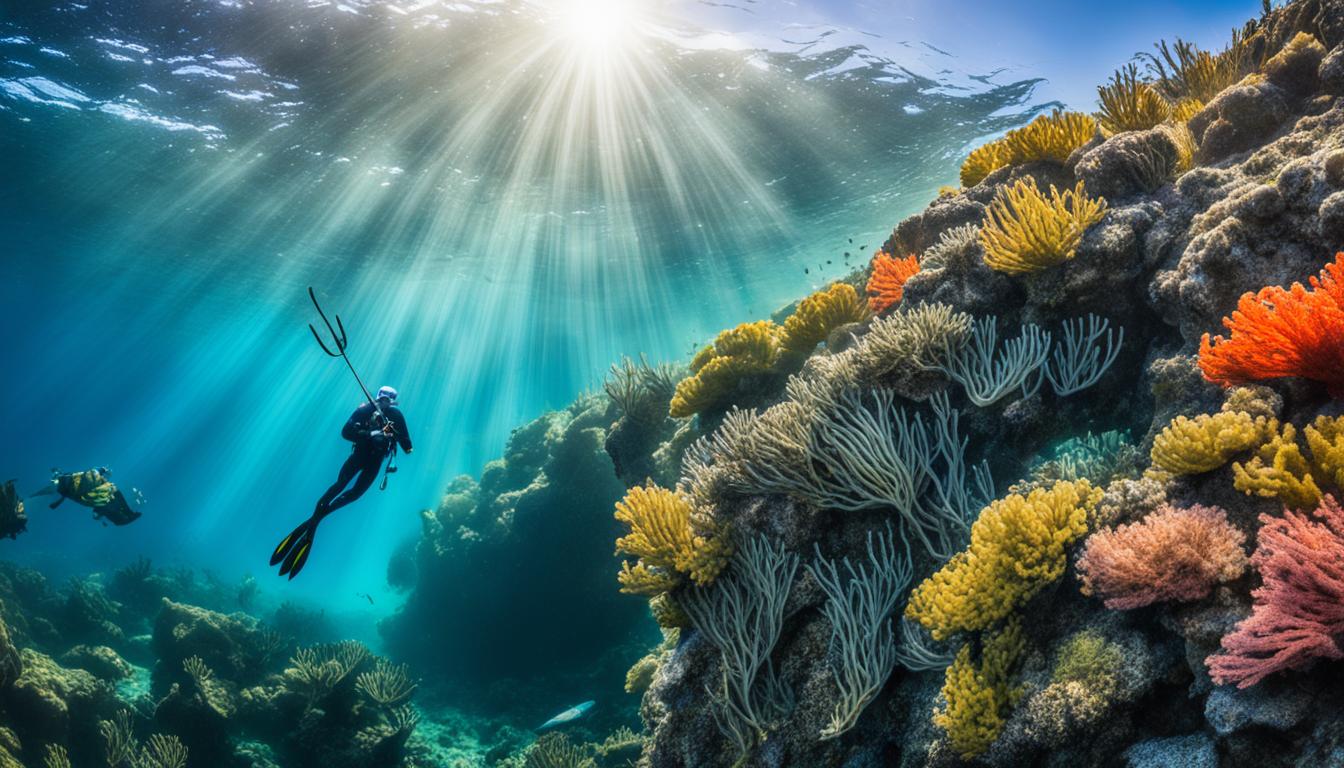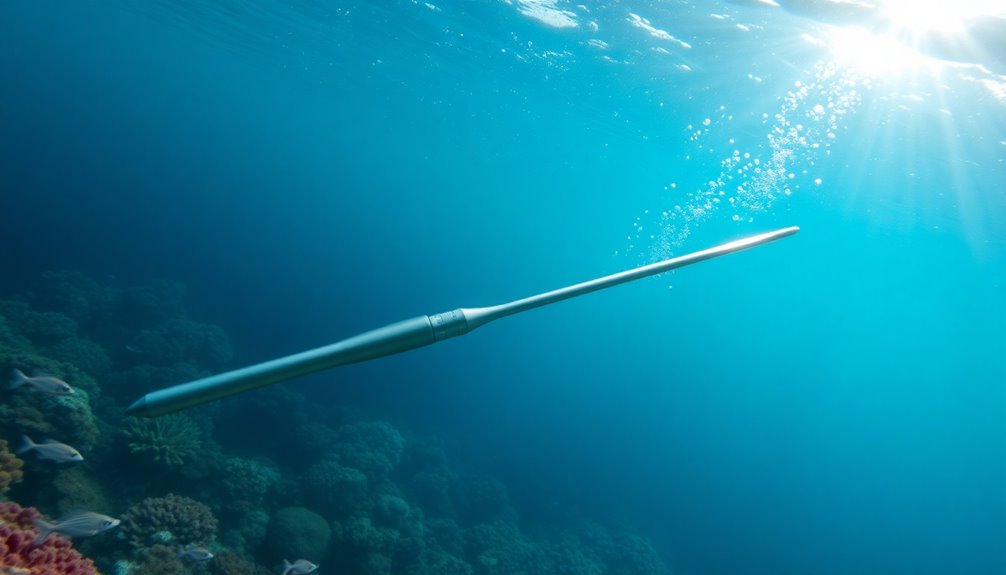Imagine standing on the rugged shoreline of South Africa, with the sun glistening on the crystal-clear waters of the Indian Ocean. The salty breeze brushes against your face as you prepare to embark on an exhilarating underwater adventure. Spearfishing, a time-honored tradition passed down through generations, awaits you.
Spearfishing is more than just a hobby; it’s a way of life. As an sustaible form of fishing, it enables you to connect with nature, while honing your skills as a hunter of the sea. Whether you’re a seasoned angler or a beginner looking to explore a new world beneath the waves, this guide is your gateway to the captivating world of spearfishing.
Before you dive into the depths, it’s crucial to equip yourself with the right gear. From starter packs to top-of-the-line equipment, the choices are vast. Spearfishing specialists like Wild Blue are ready to outfit you with everything you need to embark on your underwater journey. A starter’s pack for spearfishing starts from just under $1000, providing you with essential items to get you started.
The gear you’ll need includes freediving fins, which are about a meter long and typically have a solid, full-foot pocket. These fins allow you to move smoothly through the water, maximizing your efficiency as you search for your next catch. Additionally, a weight belt is essential for maintaining proper buoyancy underwater. The weight recommendation for lead belts in spearfishing is around a tenth of your body weight, ensuring that you can dive and maneuver effectively.
When it comes to hunting underwater, spearguns are the weapon of choice. In New Zealand, spearguns with lengths between 90cm and 130cm are commonly used, with the most useful sizes being 100cm, 110cm, and 120cm. These versatile spearguns provide the power and accuracy needed to target your desired catch.
As you venture underwater, a good floatline is essential. These lines are usually a third longer than the depth of your dive, ensuring that your catch doesn’t slip away. With basic snorkeling skills, you’re ready to start spearfishing, and with an emphasis on learning how to clear your snorkel and equalize your ears, you’ll be equipped with the necessary techniques to explore the underwater world.
So, what can you expect when you immerse yourself in the world of spearfishing? Fish targeted in spearfishing are typically found in the top few meters of the water, and a duration of about 30 seconds underwater is generally adequate for a successful catch. Spearfishing is acknowledged as a sustainable form of fishing, with minimal environmental impact thanks to its low capture rate, selectivity, and adherence to local regulations promoting marine conservation.
The spearfishing community is known for its commitment to marine stewardship. Spearfishers contribute to marine conservation efforts by adhering to local regulations, targeting invasive species, advocating for marine protected areas, and aiding in ecological research and restoration. With sustainability at its core, spearfishing is the most environmentally friendly fishing technique, producing zero bycatch.
Ready to dive deeper into the world of spearfishing? From techniques and safety measures to a comprehensive gear guide, this article will equip you with the knowledge and skills needed to embark on your spearfishing adventure. So, grab your gear, take a deep breath, and get ready to explore the depths like never before.
Key Takeaways:
- Spearfishing is a sustainable form of fishing that provides food while minimizing environmental impact.
- Essential gear for spearfishing includes freediving fins, weight belts, spearguns, and floatlines.
- Basic snorkeling skills and knowledge of local regulations are sufficient to start spearfishing.
- Spearfishing is known for its commitment to marine conservation, targeting invasive species, advocating for marine protected areas, and aiding in ecological research and restoration.
- With a focus on responsible harvesting and minimal ecological impact, spearfishing is a versatile and environmentally friendly fishing technique.
Why Learn to Spearfish?
Are you looking for a thrilling adventure that also promotes sustainable fishing practices? Look no further than SA Spearfishing! Spearfishing is not just a sport, but a way to connect with nature and appreciate the abundant beauty of the ocean. By learning the art of spearfishing, you not only gain the opportunity to catch your own food in a sustainable manner but also become part of a passionate community dedicated to preserving marine ecosystems.
Spearfishing is more than just a means to an end; it offers an extraordinary chance to explore some of the most breathtaking underwater destinations. Picture yourself swimming along vibrant coral reefs, gliding past elusive fish species, and encountering marine life in their natural habitats. It’s a truly immersive experience that allows you to witness the delicate balance of marine ecosystems firsthand.
One of the key aspects that make spearfishing such a sustainable fishing technique is its zero bycatch approach. Unlike other fishing methods that unintentionally catch non-targeted species, spearfishing enables you to select your targets carefully, ensuring no harm is done to the surrounding environment. By embracing spearfishing, you actively contribute to preserving the delicate balance of oceanic life.
As spearfishing has evolved over time, so has the technology used by enthusiasts. From the early days of tribes using sharpened sticks, modern spearfishers now wield spearguns and pole spears to increase their chances of success. Additionally, advancements in swimming goggles, diving masks, fins, and snorkels have made underwater swimming more accessible, leading to the development of modern scuba diving equipment.
When you delve into the world of spearfishing, you join a global community of adventurous anglers. This thrilling activity has gained popularity in countries like America, Australia, and South Africa, with enthusiasts eager to share tips, stories, and sustainable fishing practices. Spearfishing is more than just a hobby; it’s an opportunity to connect with like-minded individuals who value the oceans and its inhabitants. Many spearos even commemorate their underwater adventures with unique body art, using their experiences as spearfishing tattoo inspiration. These designs often feature marine life, tridents, or waves, symbolizing their respect for the ocean and the thrill of the chase. Whether you’re a seasoned diver or just starting, there’s always something new to learn in this vibrant, eco-conscious community.
To embark on your spearfishing journey, you’ll need a few essential gear items. Fins, a mask, a speargun, and a pair of dive gloves are the basics needed to get started. Additionally, honing your breath-holding skills and mastering precise speargun operation are crucial for successful spearfishing.
Whether you’re an experienced diver or a newcomer to the underwater world, spearfishing provides the perfect blend of excitement and tranquility. It’s a meditative activity that offers a sense of calm while immersing you in the dynamic and captivating underwater environment. So, why wait? Dive into the world of spearfishing and discover a whole new perspective on sustainable fishing practices and ocean exploration!
How to Spearfish: Techniques and Safety
When it comes to spearfishing, mastering the right techniques and prioritizing safety are key to a successful and enjoyable underwater adventure. Whether you’re a beginner or an experienced spearo, understanding the different techniques and safety measures will enhance your sa spearfishing experience.
Choosing the Right Technique
Spearfishing can be done in various ways, depending on your skills and the environment you’re diving in. Some popular techniques include:
- Rock hopping: Exploring rocky shorelines and hunting around their unique features.
- Reef diving: Targeting fish near coral reefs, ledges, and underwater structures.
- Bluewater diving: Venturing into deeper waters away from the coast to encounter open water game fish.
To learn these techniques effectively, it’s highly recommended to observe experienced spearfishers in action. Their knowledge and expertise will provide valuable insight into the best practices and strategies for successful spearfishing.
Ensuring Safety Above All
While spearfishing can be exciting, safety should always be the top priority. Here are some essential safety tips to keep in mind:
- Dive with a buddy: It’s crucial to have a diving partner who can assist you in case of emergencies and ensure your safety.
- Master breath-holding techniques: Proper breath control and efficient diving techniques will improve your diving abilities and maximize your time underwater.
- Stay aware of predators: Be knowledgeable about the marine life in your area and stay cautious of potential shark encounters or other aggressive species.
Remember, safety should always come first when participating in any water sport, and spearfishing is no exception. By following these techniques and safety measures, you’ll be well-prepared for a successful and secure spearfishing experience. Keep exploring, respect the ocean, and have a great time reeling in your catches!
Spearfishing Gear Guide
When it comes to sa spearfishing, having the right gear is essential for a successful and enjoyable experience. Here’s a guide to the gear you’ll need:
Masks:
A high-quality mask is crucial for clear visibility underwater. Look for a mask that fits snugly, has a comfortable silicone skirt, and a tempered glass lens.
Snorkels:
Choose a basic snorkel without unnecessary features. It should be comfortable to use and allow for easy breathing while at the surface.
Fins:
Freediving fins are designed to provide maneuverability and efficiency in the water. Look for fins that fit well in the foot pocket and have the right blade stiffness for your preference.
Wetsuits:
Open-cell wetsuits are best for sa spearfishing as they provide maximum insulation and flexibility. Opt for a wetsuit without zips to minimize water entry and improve hydrodynamics.
Weight Systems:
A weight system is used to help divers achieve neutral buoyancy. Choose a system that allows for easy adjustment and distribution of weights.
Spearguns:
There are different types of spearguns available, including pole spears, Hawaiian slings, pneumatic guns, and band guns. Select a speargun based on your target fish and shooting range.
Floats:
Floats are essential for safety and to prevent fish from swimming into deeper waters. Look for a float that is visible, easy to tow, and has a line strong enough to secure your catch.
Remember to always research and invest in high-quality gear to ensure your safety and the sustainability of the marine environment. With the right gear, you’ll be well-prepared for your next spearfishing adventure!

Talk Like a Spearo
When diving into the world of SA spearfishing, it’s essential to understand the unique terminology that is frequently used within the spearfishing community. These specialized words and phrases not only serve as a shorthand for communication but also foster a sense of camaraderie among spearos. So, as you embark on your spearfishing journey, let’s dive into some common spearfishing terminology and get you speaking the language of the spearfishing community.
1. Spearo
In the spearfishing world, enthusiasts and participants are often referred to as “spearos.” It’s a term that captures the passion and dedication of those who engage in this exhilarating sport. Being a spearo symbolizes a deep connection with the ocean and a commitment to sustainable and ethical fishing practices.
2. Spot burning
Spot burning is an unwritten rule within the spearfishing community. It refers to the act of revealing or disclosing secret or productive fishing spots. Spearos hold their fishing locations in high regard, and sharing them can lead to overcrowding and depletion of fish populations. Respect for fellow spearos and the environment means protecting these coveted spots.
3. Social media etiquette
In the age of social media, spearos have formed a vibrant online community. However, posting photos and videos of spearfishing adventures comes with its own set of etiquette. It’s crucial to strike a balance between sharing the thrill of the sport and respecting the need for secrecy around sensitive locations. Spearos often use hashtags like #KeepItClean and #RespectTheOcean to remind each other to be responsible digital citizens.
4. Dive watch
A dive watch is an essential piece of equipment for any serious spearo. These watches are specifically designed to withstand the pressures of underwater diving. They often have features like water resistance, depth gauges, and timers to help spearos track their dive times and depths accurately.
5. Target species
Throughout South Australia, spearos pursue an abundance of target species. From prized fish like abalone and flatheads to other great eating fish, the species you seek will depend on your location and personal preferences. Understanding the habits, habitats, and regulations surrounding these target species is key to a successful and sustainable spearfishing experience.

“Being a part of the spearfishing community is like joining an exclusive club with its own language and code of conduct. Embracing spearfishing terminology helps you connect with fellow spearos and deepen your appreciation for this thrilling sport.” – Nicole Burko
By familiarizing yourself with the language of the spearfishing community, you’re not only expanding your vocabulary but also gaining insight into the shared experiences and values that unite spearos worldwide. So, next time you’re out on the water, dive into the lingo, connect with fellow spearos, and become a true part of the spearfishing community.
Where Can You Go Spearfishing?
When it comes to spearfishing, the world is your oyster. From the captivating shores of South Africa to the picturesque waters of New Zealand, there are countless destinations waiting to be explored by adventurous anglers like you. Each location offers its own unique charm, diverse marine ecosystems, and a bounty of fish species to target.
One of the top spearfishing destinations worth mentioning is the Wild Coast in South Africa. Spanning approximately 560km, this rugged coastline provides a thrilling backdrop for spearfishing enthusiasts. With its stunning coral reefs and abundance of fish species, including pelagic fish, marlin, tuna, mackerel, kingfish, and dorado, the Wild Coast offers an unforgettable spearfishing experience.
Hout Bay Harbour in Cape Town is another must-visit destination for spearos. It is home to reputable fishing charter companies such as Hooked on Africa and Wild Ocean Fishing Charters. These experts know the best spots to target different fish species, ensuring a successful and thrilling spearfishing adventure.
The Greater St Lucia Wetland Park, a World Heritage Site located between Kosi Bay and St Lucia, is a paradise for spearfishing enthusiasts. Its diverse marine environments, including estuaries, lakes, and coral reefs, provide endless opportunities to explore and discover the underwater wonders of South Africa.
For those seeking fantastic spearfishing opportunities influenced by powerful ocean currents, Mossel Bay in the Western Cape is the ideal destination. Situated at the confluence of the Agulhas and Benguela currents, this area boasts a diverse range of fish species, promising exciting spearfishing encounters.
If you find yourself near Cape Agulhas, make sure to visit Struisbaai. This popular spearfishing spot offers a wealth of fish species for enthusiasts to target. Whether you’re in search of reef fish, game fish, or pelagic species, Struisbaai will not disappoint.
From the stunning coral reefs to the diverse fish life, South Africa offers a unique spearfishing experience that will leave you with unforgettable memories. Make sure to respect local regulations, practice sustainable fishing methods, and thoroughly research each destination’s specific rules and restrictions before embarking on your spearfishing adventure.
| Spearfishing Destinations | Notable Features |
|---|---|
| Wild Coast, South Africa | – Spanning approximately 560km – Abundance of fish species |
| Hout Bay Harbour, Cape Town | – Fishing charter companies – Expert knowledge of local spots |
| Greater St Lucia Wetland Park, South Africa | – Diverse marine environments – World Heritage Site |
| Mossel Bay, Western Cape | – Influence of Agulhas and Benguela currents – Diverse range of fish species |
| Struisbaai, South Africa | – Popular spearfishing destination – Diverse fish species |
Remember, spearfishing is not just a thrilling adventure but also a sustainable fishing method. With close to zero bycatch and no litter, it offers a safe and healthy way to fish. As responsible anglers, let’s protect and preserve our marine ecosystems for future generations to enjoy.
For the latest information on spearfishing areas along the metropolitan Adelaide coastline, including maps, visit www.pir.sa.gov.au/fishing/closures_and_aquatic_reserves/fishing_closures.

Is Spearfishing Safe?
Spearfishing, an ancient method of fishing, has evolved over millennia into a modern underwater sport. While it can be a thrilling and rewarding activity, safety should always be a top priority for spearfishers. Understanding and adhering to safety precautions is crucial to enjoy a safe and successful spearfishing experience.
To ensure your safety while spearfishing, it is recommended to:
- Dive with a buddy: Spearfishing is best enjoyed with a partner. Having a buddy by your side provides an extra layer of safety and allows for quick assistance in case of emergencies.
- Follow safety procedures: It is essential to be trained and knowledgeable in safety procedures, such as managing blackout or samba situations. These techniques are vital in preventing accidents and ensuring your well-being during breath-holding dives.
- Be aware of potential dangers: Spearfishing takes place in the ocean, which means encountering marine predators is a possibility. Be cautious and educated about the marine life in your diving location, follow local guidelines and regulations, and respect their natural habitat.
- Respect other water users: It is important to be mindful of other water users, such as swimmers, surfers, and divers. Avoid crowded areas where the risk of accidental collisions is higher and always prioritize safety for everyone involved.
- Adapt techniques to the environment: Different spearfishing techniques, such as snorkeling, freediving, and scuba diving, require specific skills and safety considerations. Choose the technique that suits your experience level and the environment you will be diving in. Ensure you are properly trained and equipped for the chosen method.
By following these safety precautions, spearfishing can be a safe and enjoyable activity for adventurers seeking an underwater thrill. Remember to always prioritize safety, stay informed about local regulations, and respect the ocean and its inhabitants.
Spearfishing Safety Precautions
| Safety Precaution | Description |
|---|---|
| Dive with a buddy | Spearfishing is best enjoyed with a partner who can provide assistance in case of emergencies. |
| Follow safety procedures | Be trained in managing blackout or samba situations to prevent accidents during breath-holding dives. |
| Be aware of potential dangers | Understand the marine life in your diving location to avoid potential encounters with predators. |
| Respect other water users | Mindful of other water users and prioritize safety to avoid accidental collisions. |
| Adapt techniques to the environment | Choose the appropriate spearfishing technique based on your experience level and diving environment. |
Remember, spearfishing can be a safe and fulfilling activity with proper preparation, knowledge, and adherence to safety guidelines. Enjoy the thrill of exploring the underwater world while prioritizing your safety and the preservation of marine life.

The Essence of Spearfishing
Spearfishing combines ancient traditions with modern technology, requiring skill, knowledge of marine behavior, and a commitment to sustainable fishing practices that respect the marine environment. It is a unique experience of underwater hunting that immerses you in the rhythm of the ocean. Spearfishing fosters a deep connection with the sea and promotes sustainable fishing practices.
Over the last 10 years, the average price of diving masks has remained relatively stable. A mask 10 years ago was approximately R400. Companies such as Cressi, Mares, Omer, Technisub, Rob Allen, and Sporasub are competing to perfect spearfishing masks, providing consumers with a wide array of choices.
The volume of diving masks plays a crucial role for spearfishermen in terms of comfort and function. The Cressi Occhio Plus mask surprisingly has a low volume of 95ml, challenging the perception of its size. The Mares Essence mask was found to have the highest volume test result during the review, indicating that volume may not be a decisive factor for all spearfishermen. The Cressi Eyes Evolution mask, priced at approximately R700, offers good all-around vision with 36.5% visibility on the grid tested.
Spearfishing involves a relatively low number of billfish shot annually compared to those caught in tournaments, recreational fishing, and commercial fishing. It is known for its selective harvesting, targeting only mature, healthy billfish to minimize impact on future generations. Spearfishing also results in minimal bycatch due to the method of directly targeting specific fish. With this approach, spearfishermen have a lower impact on marine habitats as they dive to specific locations, avoiding sensitive ecosystems.
Sodwana Bay in South Africa offers a variety of dive sites popular for spearfishing, such as 5-Mile Reef, 7-Mile Reef, 9-Mile Reef, and Jesser Canyon. This stunning location provides the perfect backdrop for spearos to explore the underwater world and practice their skills. The Rabitech Predator Pro Wetsuit, crafted from top-quality Yamamoto Open Cell Material, provides exceptional warmth and comfort for divers. With its 5mm thickness and Brown Camo design, the wetsuit offers durability and effective camouflage for spearfishing.
When it’s time to take a break from the water, spearfishing enthusiasts can gather at Coral Divers Restaurant in Sodwana Bay. Known for its fresh seafood and ocean views, the restaurant creates a vibrant atmosphere where spearos can share stories, exchange tips, and enjoy delicious meals. For comfortable accommodations, Mseni Beach Lodge in Sodwana Bay offers thatched chalets and beach cottages, catering specifically to spearfishing enthusiasts. This lodge serves as a retreat where spearos can relax, connect with like-minded individuals, and gain access to nearby dive sites.

Conclusion
As you have explored the world of SA spearfishing, you have discovered the thrill and adventure it holds. By embracing sustainable fishing practices and being part of the spearfishing community, you can ensure a positive impact on the marine ecosystem and contribute to its conservation for future generations.
Recreational spearfishers, although representing a small percentage of marine recreational fishers, play a vital role in promoting sustainable fishing practices. Targeting species of moderate to high levels of vulnerability and being selective in their approach, spearfishers contribute to maintaining the balance of the marine ecosystem.
Through anecdotal evidence and the insights of experienced spear fishermen like Maurie Glazier, the impacts of spearfishing on fish populations have become evident. However, with the ban on commercial spearfishing and a focus on recreational spearfishing in Australian states, efforts are being made to ensure the long-term sustainability of this activity.
However, it is essential to recognize the vulnerabilities and potential negative impacts that spearfishing can have on specific sites and the need for responsible management regulations. By comparing Australian fishery management frameworks with international benchmarks like the FAO Code of Conduct for Responsible Fisheries, we can strive for the application of the precautionary principle in all fishing activities.
By embracing sustainable practices and being knowledgeable about the impacts of spearfishing, you can enjoy the thrilling experience of spearfishing while minimizing harm to the marine ecosystem. Together, we can ensure the preservation of our ocean’s biodiversity for generations to come.










